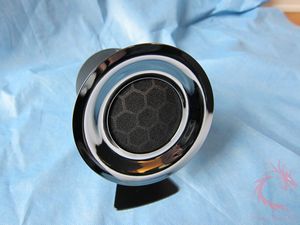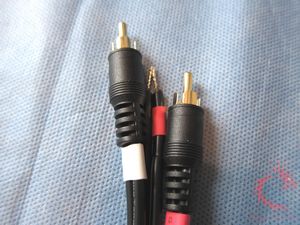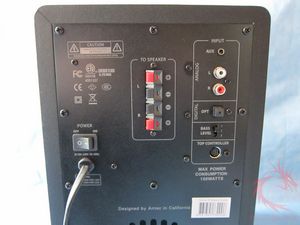For today’s
review we will be checking out the latest PC case err, speaker system
from Antec. Did I just type speaker
system??? Antec, a company known for
their PC cases, enclosures and other peripherals have entered into the PC
speaker market and today we will look at their first product – the rockus
3D.
Antec created
the soundscience subsidiary to distinguish these products from their widely
known business model of PC cases and power supplies. Their first audio product from
the soundscience brand is the 3D which is a 2.1 system
designed to create a virtual 3D sound stage. Introduced at the $249 price point they seem to be going after the
higher end 2.1 speaker systems especially designed for PC use.
Antec Sound Science rockus 3D Speaker System
Reviewed by: Tomas
Ratas
Sponsor: Antec
Tech Specs,Features or the Basic Info:
Antec
Sound Science rockus 3D Speaker System
-3Dsst delivers best in class
surround sound simulation
-Two Aluminum Constructed
Satellites
-Digital Optical (TOSLINK) input
-2 dedicated listening modes
provide optimal sound reproduction
The rockus 3D | 2.1 speaker system
creates a personal home theater experience that brings the power and realism of
3D audio together with the clarity and accuracy of high-fidelity music.
3Dsst, soundscience’s 3D technology, actively analyzes incoming stereo
audio signals and intelligently places them into a 3D sound field. The results
are a personal theater experience with realistic, immersive 3D sound for your
movies and games from 2.1 speakers – whether it’s the impact of an explosion,
the snap of a baseball whizzing by a player’s face, or the thunder and fury of
a videogame gunfight.
The rockus also features a dedicated
music mode optimized for superb stereo sound reproduction, letting you hear
your music with deep, visceral sub-bass and spacious crisp, mids and highs.
soundscience puts 3D cinematic sound and high-fidelity music in its place: Your
room.
Anodized Aluminum Satellites
Anodized aluminum satellites reduce vibration and minimize distortion,
resulting in clear mid and sparkling high-range sound. Plus 3D-tuned drivers
deliver audio optimized for soundscience’s 3Dsst technology.
Remote Control Pod
Easily adjust volume, 3D/music mode selection, muting and digital/analog input
selection.
Active Subwoofer with Passive Radiator
The passive radiator creates an extended low frequency response, producing deep
bass from a compact subwoofer enclosure, eliminating the need for a larger,
bulkier subwoofer.
Optical (TOSLINK) Input
Allows for direct connection of digital audio outputs on video game consoles,
home A/V components, CD players, DVD/Blu-ray players, and more.
2 satellite speakers, subwoofer,
remote controller, 3.5mm to 3.5mm cable,
speaker cable – speaker cable – 2 x RCA to open end RCA to 3.5 mm cable, remote cable
Configuration
2.1 Dimensions Satellite Speakers 5.7” (H) x 6.3” (D) x 4.7” (W)
144.8 mm (H) x 160.0 mm (D) x 119.4 mm (W)
Subwoofer 13.8” (H) x 10.6” (D) x 7.7”
(W)
350.5 mm (H) x 269.2 mm (D) x 195.5 mm (W)
with 6.5″ diameter subwoofer
Weight 8.5 kg / 18.7 lbs
Output Total 150 Watts Satellite
Speakers 25 Watts / each
Subwoofer 100 Watts Maximum Output
S.P.L 95 dB Inputs Analog 3.5mm, RCA Digital Optical
Price:
$153.26 (from Amazon at time of review)
If you are looking to take your speaker system outdoors, look into rock speakers. They look great, and are weather resistant.
{mospagebreak title=A Better Look at things}
A Better Look at Things
:
The soundscience rockus arrives in a black cardboard
package with two large images of the satellite speakers on the front. The top
of the package highlights the control features of the remote control knob;
while the back of the package lists features of the speaker system.
Opening the box we find the
subwoofer, two satellite speakers, volume control knob, several audio cables,
an AC adapter and instruction booklet; all packed in a protective Styrofoam.
The system is rated for 150 Watts
of total output with the subwoofer contributing 100 Watts while the satellites
each pass 25 Watts a piece. The
frequency response for the soundscience rockus is 10 Hz-20 kHz.
Since the satellite speakers are
what sit on one’s desk lets take a look at them first. Soundscience eschewed the typical speaker appearance
by going with a “tomato can” shaped body. These satellites each measure 5.7”
(H) x 6.3” (D) x 4.7” (W).
They are tilted up at an
approximate 15 degree angle to aim the sound towards the listener’s head when
place on a desk. Unfortunately the
speakers are fixed at this angle and can not be adjusted; thus any positions
other than on a desktop may impair the sound quality of the soundscience
rockus.
The body of the satellite speaker
is composed of black anodized aluminum with the soundscience name imprinted on
the top side of the speaker. On the
front of the satellites is a plastic silver ring that serves no purpose other than
for cosmetics. These rings seem to be fingerprint
magnets, so try and avoid grabbing the speaker by this section. On the speaker grill a honeycomb pattern is
found.
Since the satellite is composed
of aluminum, it is heavier than typical plastic speakers found with other
brands. The speaker stand is
non-adjustable and is also composed of aluminum. On the back of each satellite is an RCA
connector which inserts to the included audio cable that has standard speaker
wire on the other end for the subwoofer attachment.
Appearance wise, the soundscience
rockus satellite speakers are unique looking and well constructed. They are low profile enough that they do not
stand out on one’s desk.
Next we look at the subwoofer which
measures 13.8” (H) x
10.6” (D) x 7.7” (W), somewhat narrower
and smaller than most subs. Don’t let
its compact appearance fool you as it packs a punch. It is
composed of black wood housing with a cloth front grill covering that protects
the front firing subwoofer.
On the back
are a series of connectors and inputs including two speaker output connections,
two analog audio inputs (one 3.5 mm and RCA), one digital TOSLINK optical
input, a connector for the remote control and a Bass level switch with three
settings. Just above the AC cable is a
power switch.
Most speakers
worth their salt have a digital connector of some type, so it is nice to see
Antec included the TOSLINK. One negative
is the three setting bass control, as fine tune control of bass would seem more
useful.
The remote of
the soundscience rockus is certainly different from other 2.1 speaker setups as
it is primarily a volume knob. Some may
find this remote a turn off so to speak and prefer something more digital such as
the controls found on the Logitech high end PC speaker setups. I personally prefer the analog control of the
volume using the knob remote.
Antec colored
the remote silver on the top button/knob and black on the base to match the
rockus’ aesthetic. The soundscience logo
is printed on the side of the remote with a small silver button in the middle
of the front base which toggles between 3D or “music” mode when quickly pressed
or switched between analog and digital sources when held for three or more
seconds.
The top of
the knob functions as a button which mutes and unmutes the rockus. On the front of the device are four indicator
lights. One light indicates analog or
digital source, the next two identify whether in “music” or 3D mode and the
last is the mute indicator which lights up when the speaker is silenced by the
user. The back of the remote is where
the cable from the subwoofer connects.
Besides the speakers, subwoofer and remote Antec also included
connection cables. Analog mini-jack
to mini-jack and mini-jack-to-dual-RCA cables are provided but strangely no
optical cable. Cables for the satellites
and remote are in the box as well.
Installation, Testing and Comparison
For testing I hooked the soundscience rockus to my main PC via both
Optical and Analog connections. The test
PC is an Asus P8P67 PRO which uses the Realtek ALC892 8-Channel High Definition Audio CODEC and has both
optical and analog 3.5 mm inputs. For
comparison I pitted the soundscience rockus against a Logitech Z-5500 which is
a 5.1 audio system. Since I use
this machine for gaming, watching video and listening to music, I felt it was
an excellent test platform.
Setup the system up
took less than five minutes. The inputs
on the back of the subwoofer allow up to three devices to be connected to the
soundscience rockus at once. For
instance you can attach the PC to one of the analog connections, a current
generation console to the TOSLINK optical and iPod to the spare analog
connection. The compact size of the
subwoofer made it simple to tuck it out of site behind my desk. The black and silver satellite speakers
blended in nicely with the black monitor bezels on my desktop.
One complaint with
the setup is the length of the cables as they come on the rather short
side. If you want you speakers farther
away from your desk you’ll need to get an extension cable or speaker wires to
achieve greater distance.
Antec created the Rockus with two sound stage settings – “music” and
3D. Music is the default mode drives the
speakers like a normal 2.1 sound system. 3D employs 3Dsst,
soundscience’s 3D technology. This sound
field creates a simulated surround sound set up which is never on par with a
5.1 arrangement but can make certain audio playback feel more dynamic. I found the 3D effect worked great in videos,
for instance while watching a rain scene in a TV show, the sound of rain was
projected behind the dialogue coming from the actor’s mouths.
I listened to a wide range of musical styles and found the soundscience
rockus to have strengths and weaknesses. Softer music such as Neil Young’s “After the Gold Rush” sounded crystal
clear, while the Black Key’s “Everlasting Light” produced some noticeable
distortion. The low end was well reproduced
via the subwoofer while the mids and highs were sometimes lacking and flat
sounding especially with grungier sounding music.
The 3D button should NOT be employed during music playback as it renders
the source material hollow and echo-y sounding. Keep the music button active at all times when listening to tunes otherwise
people will think your speakers are out of whack.
Where the 3D button really impresses is with gaming and video
playback. In these playback settings the
soundscience 3Dsst technology
really shines. 3Dsst is designed to
create a virtual surround sound environment which is does capably. Games
where spatial recognition is critical such as 1st person shooters
like Call of Duty or Battlefield worked well in conjunction with the soundscience
rockus.
Videos are where the soundscience rockus really stood out. I used the Blu-Ray version of The Dark Knight to test the virtual
3D. The punches thrown had a satisfying
thud while the whirring of the Bat-Cycle in the chase scene sounded similar to
when I first watched it in IMAX. Sounds
moved across the speakers in synchronicity with the action on my monitors.
Putting the soundscience rockus into music mode during video playback
gave the audio a flat sound; like listening to audio from a standard definition
TV without stereo. Obviously the 3D
virtual sound stage does not sound better than the 5.1 playback but it comes
pretty close.
As with any audio
product testing is partially subjective and each listener may hear something
slightly different. When comparing the
audio from the soundscience rockus to the Logitech z-5500 they actually sounded
quite similar when head to head in 2.1 audio modes.
If you are looking to take your speaker system outdoors, look into rock speakers. They look great, and are weather resistant.
Summary:
Antec’s first audio product – the soundscience rockus 3D has its pros
and cons. It is well designed in terms
of appearance, construction and build quality. The system offers three audio inputs, including a digital TOSLINK for
connecting multiple devices at once. The 3Dsst
mode provides a dynamic virtual surround sound stage for videos and games.
The drawbacks
to the soundscience rockus 3D includes the lack of THX, DTS, SRS
and Dolby certification especially with a digital enabled connection. For its price point Antec could have included
an optical cable and some longer connecting cords. The flat sounding mids and
highs with music playback are another concern although these were some of
better sounding 2.1 speakers playing from a PC that I have used.
Originally the Antec soundscience rockus was released with a retail
price of $249 which is quite high for a 2.1 setup. Fortunately it is currently available on
Amazon for $153.26 putting it at a price point with less feature packed 2.1 systems making this
setup hard to pass up.
DragonSteelMods gives the rockus
3D Speaker System a 4 out of 5 score.

Pros:
+3Dsst works
well especially with games and videos
+Sleek appearance
+Solid construction
+Three music inputs
+Included TOSLINK optical
Cons:
-Lack of THX, DTS, SRS and Dolby certification
-Short cables
-No optical cable included
review# 698
Disclosure: This product was given to DragonSteelMods for review by the company
for review purposes only, and is not considered by us as payment for the review; we do not, never have, and never
will, accept payment from companies to review their products.
To learn more about our review policy, testing methods
and ratings please see this page.



























